Top News
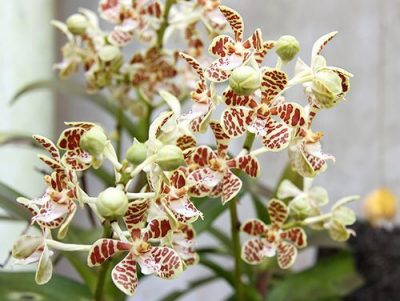
April 27, 2020 Ryukyu Shimpo
By Mitsuo Kochi
The Iriomote orchid, or Iriomote-ran, a treasured orchid species said to be extinct in the wild, successfully bloomed under the care of an orchid hobbyist in Nago City. The grower has carefully tended to the plant since purchasing it from a retailer 40 years ago.
Iriomote orchids belong to the orchid family. In the wild, they grow on large trees and its stems tend to shoot upward. Because the bulbs emerge at the base of the stem, the plant multiplies quickly. However, Iriomote orchids are now rarely found in the wild, as its population has dropped sharply from overharvesting. The Ministry of the Environment and the prefecture have designated it an endangered species. Its habitat distribution includes Iriomote Island and Taiwan.
(English translation by T&CT and Monica Shingaki)
Go to Japanese
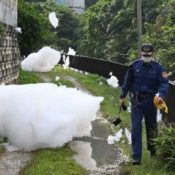
April 24, 2020 Ryukyu Shimpo
By Takaya Kinra
On April 10, in relation to the incident of organic fluorine compounds (PFAS) such as PFOS, which are suspected to be carcinogenic, being discharged from Futenma Air Station, the Ryukyu Shimpo requested that Associate Professor Koji Harada of Kyoto Univesity analyze samples collected from 5 rivers and other waterways in the vicinity on April 11-13 for organic fluorine compound content. The results of this analysis show that 247.2 nanograms (ng) of PFOS/PFOA (per liter) was detected in water collected from Uchidomari River in Ginowan City, which is six times the provisional index value of a total of 40 ng/L
underground water contamination determined by the U.S. military. Four sites from which water was collected were detected to contain high levels of organic fluorine compounds. High concentrations of organic fluorine compounds such as PFOA and PFHxS were detected, as well as PFOS which the U.S. military has declared is contained in a fire extinguishing agent.

In the United States, if levels exceed provisional index values formulated by the Environmental Protection Agency (EPA), the EPA recommends further investigations. This time, in each of the water samples in which levels exceed the index value, the PFOA value was higher than the PFOS value.
In general river water or the like, the total PFOS/PFOA content is about 10 ng/L. A panel of experts from the Ministry of the Environment’s Central Environmental Council has proposed 50 ng/L as a provisional index value, but the values detected at this time greatly exceed this value. Professor Harada pointed out, in regard to these results, “Environmental pollution from U.S. military bases is certainly rising”.
For this analysis, water samples were collected from 5 spots such as the surroundings of Uchidomari River and Makiminato fishing port in Urasoe City. The highest total level of PFOS/PFOA was 247.2 ng/L, collected at Uchidomari River on April 12. The next highest value was 144.0 ng/L in water collected from a pool of water along the same river, collected on April 11, which is still 3.6 times the provisional index.
At a point at which the river converges with a subterranean drain through which water from on the military base flows, a high level of 50.0 ng/L (collected April 13) was detected, meanwhile, water upstream from the confluence point had a lower value of 30.2 ng/L (collected April 12). Seawater from Makiminato fishing port (collected on April 12) contained 41.0 ng/L, exceeding the provisional index value.
PFOS/PFOA
PFOS/PFOA are varieties of organic fluorine compounds. As suspected carcinogens, the production and use of PFOS is internationally restricted by the Stockholm Convention on Persistent Organic Pollutants (POPs Treaty). In Japan, except for in some cases, the use and production of these is generally prohibited. External organizations of the World Health Organization (WHO) have indicated PFOA as a substance liable to be carcinogenic, and chemical manufacturers are voluntarily abolishing use of PFOA. As a substance, it is highly stable, so it does not substantially decompose in the environment, and poses the danger of accumulating in living organisms.
・・・・・・・・・・・・・・・・・・・・・・・・
In response to an incident on April 10 during which a foaming fire extinguishing agent was discharged on Futenma Air Station, on April 11 around 9:00 a.m. the Ryukyu Shimpo sampled a pool of water, which sits alongside Uchidomari River (Hiyara River) in Ginowan City and to which large quantities of foam clung. At around 7:00 p.m. on April 12 a water sample was collected at a point about 50 meters upstream from a confluence point at which Uchidomari River converges with a subterranean drain through which water from on the military base flows. After 7:00 p.m., water was sampled from Uchidomari River, after the large quantities of foam from April 11 had scattered. At about 7:30 on April 12 seawater was collected from Makiminato fishing port. At about 7:00 p.m. on April 13, water was collected about 100 meters upstream from from a confluence point at which Uchidomari River converges with the subterranean drain. The collected water samples were sent to Kyoto University on April 16 to be analyzed by Associate Professor Koji Harada, as requested. The results were released on April 22. These results showed organic fluorine compound PFOS and similar substances, and upon investigation it appears that 13 varieties of organic fluorine compounds are included in the foaming fire extinguishing agent.
(English translation by T&CT and Erin Jones)
Go to Japanese
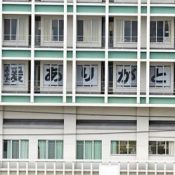
April 23, 2020 Ryukyu Shimpo
On April 22, hospital workers at Okinawa Prefectural Nanbu Medical Center & Children’s Medical Center posted a sign in the fourth-floor windows of the east wing that read, “Thank you for your support.” The facility, which treats COVID-19 patients, has been receiving donations of face masks and snacks from locals in support of their work.
The center’s director, Touru Wake said, “Some people donated the few masks they had left. Our doctors, nurses, and staff are fighting [the coronavirus] while coping with anxiety. We are very grateful for everyone’s support.”
Nanbu Medical Center is doubling down on its efforts to deal with the recent outbreak of the novel coronavirus, and in order to secure nurses to treat COVID-19 patients, it transferred in-patients occupying the fourth floor of the east wing to other medical facilities.
(English translation by T&CT and Monica Shingaki)
Go to Japanese
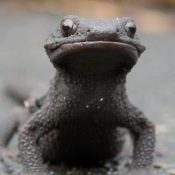
April 23, 2020 Ryukyu Shimpo
Northern Okinawa – In Nago, there are many cases of Anderson’s crocodile newts becoming roadkill. The Anderson’s crocodile newt (family Salimandriae) is nicknamed “the living fossil,” and is a natural monument designated by Okinawa prefecture. The Nago Museum released the following statement: “Some people are visiting northern Okinawa by car in order to avoid the 3Cs and the novel coronavirus, but please be careful when driving on roads near rivers.”
From the night of April 20 to the morning of the 21st, twelve of the newts died on a forest road that goes up to the peak of Nago Mountain. This was confirmed by a member of the Friends of Nago Museum. The breeding season of the Anderson’s crocodile newt begins in late March and goes through April. It is thought the newts may have come into the road to eat worms and were then hit by passing cars.
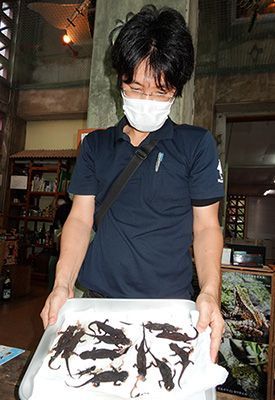
The twelve Anderson’s crocodile newts thought to have been run over on a Nago Mountain forest road. (April 21, Nago Museum, Nago)
Naofumi Murata, curator of the Nago Museum, says, “these newts are largely extinct in the southern part of the island; they are a rare creature. If you see one, please lure it to the side of the road.” Hinako Miyazato says, “the Anderson’s crocodile newt species retains primitive characteristics and is designated as a national endangered species. I would like for every single one of us to be careful and reduce the number of newts that end up as roadkill.”
(English translation by T&CT and Ellen Huntley)
Go to Japanese

April 23, 2020 Ryukyu Shimpo
By Eriko Tamaki
Orion Breweries, Ltd., (Keiju Hayase, Representative Director andPresident), announced April 22 that they would cease production of the high-alcohol version of their chuhai beverage, “Watta Strong.”
The high alcohol content in the “strong” version of chuhai beverages have been indicated as a contributing factor for alcoholism and damaging to health. These indications were the basis for the company to cease production, and “No longer sell strong chuhai.”
The Watta series was Orion’s first line of canned chuhai beverages, debuting in May, 2019. With an alcohol-by-volume (ABV) from 3% to 9%, they sold a variety of types including limited editions.
Their 9% ABV “strong” chuhai include the year-round “Fruits Shikuwasa mix” and “Dry shikuwasa” flavors, and the limited edition “passion fruit.” Production for these beverages ended at the end of January this year, and sales will end once the current stock has run out.
Strong chuhai are cheaper than beer or happoshu (a low-malt beer-like beverage), but have almost double the ABV than beer at 9%, which has gained the drink popularity as a “cheap drunk,” with sales that continue to expand.
However, according to doctors who are working on policies to combat alcoholism, a large intake of alcohol can lead to an increased risk of developing alcoholism.
According to Orion Breweries, since the debut of Watta Strong through March 24 of this year, approximately 1.66 million cans have been sold for a sales revenue of just over 170 million yen, roughly 40% of the Watta series sales total.
The brewery’s PR representation explained, “Upon learning the societal harm caused by high-ABV beverages, we conducted an investigation internally. As we have an obligation to contribute to the health of Okinawans, we have decided to stop selling high-ABV beverages.”
(English translation by T&CT and Sam Grieb)
Go to Japanese
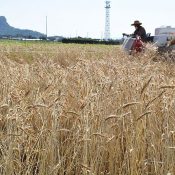
April 21, 2020 Ryukyu Shimpo
By Special Correspondent Yukito Kinjo
Iejima – In Ie village, where wheat production in Okinawa thrives, the color of gold has spread throughout the wheat fields, and farmers begun harvesting their crop, starting at the end of March onwards. On sunny days, farm workers can be seen driving their combines, collecting wheat.
In a wheat field in Nishieue, the wheat stalks dance in the breeze and bathe in the sun against the backdrop of Gusukuyama, a symbol of the island, a pleasing sight for villagers.
At Iejima Kazoku, a company that grows, processes, and produces products from wheat on Iejima (Kentoku Tamaki, president), their “Kekkun” wheat chips are popular. They come in salted, cinnamon, and spicy flavors, and are even sold on the shelves of supermarkets and convenience stores in mainland Japan.
According to a representative from the company, due to this year’s favorable weather, crop conditions surpassed the previous year, and are predicting an increased yield. The harvest will continue through the end of April.
(English translation by T&CT and Sam Grieb)
Go to Japanese
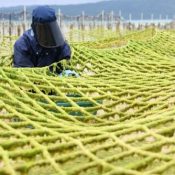
April 20, 2020 Ryukyu Shimpo
At a sea lettuce farm in Yaga, Nago City, the asa sea lettuce—a popular spring food, is in peak harvest. The blooming asa has covered the coast in a beautiful green carpet.
On the morning of April 19, sea lettuce farmers went out to the beach during low tide and carefully picked asa off the nets. Harvest begins in March and is expected to continue through April.
Beads of sweat lined the forehead of a 55-year-old female worker as she collected the algae. “It’s a physically demanding job, but I’ll be happy if it sells well,” she said.
(English translation by T&CT and Monica Shingaki)
Go to Japanese
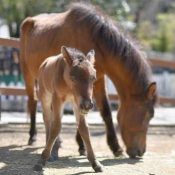
April 17, 2020 Ryukyu Shimpo
By Yuki Muramatsu
Yonaguni – At dawn on March 20, an eagerly-awaited male foal was born to Auri and Meri, Yonaguni horses at Rakujyu-en, a public park in Mishima, Shizuoka. On March 26, Toshio Sakimoto, chair of the Yonaguni Tourism Association received an email sharing the happy news from the head of the Department of Industry and Cultural Affairs at Mishima City Hall.
In 2018, Rakujyu-en representatives asked to purchase Yonaguni horses. Working with the Yonaguni Horse Preservation Association and other groups, it was decided to provide the park with two (one male, one female) of the horses that are a natural monument of Yonaguni. Sakimoto, who was involved in the process, recently received a message thanking him.
With stories of coronavirus dominating the news, the birth of the foal is a bright spot that has enlivened Rakujyu-en. Everyone is eager to share the joy: there are plans to organize events announcing the foal’s name and formally presenting him.
Sakimoto is from Yonaguni and has grown up seeing Yonaguni horses up-close. He says, “Of course the birth of a horse is a happy occasion, but I’m surprised anew to see how much joy the Yonaguni horses bring to people outside of Okinawa and how much they are treasured and loved. I hope that the Yonaguni horses become a reason for people in Mishima to learn about our island, to feel connected to it, and to be interested in it. If the foal becomes a bridge that connects Mishima and Yonaguni, I will be even happier.”
(English translation by T&CT and Ellen Huntley)
Go to Japanese
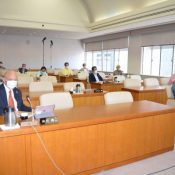
April 16, 2020 Ryukyu Shimpo
On April 16, Satoru Nakasone, chairman of the Special Committee on Affairs of U.S. Military Bases, presented a letter of protest at the prefectural assembly. The letter was written in response to the accident in which a firefighting foam containing the harmful substance PFOS (perfluorooctanesulfonic acid) had leaked and spread from U.S. military Futenma airfield. The special committee had unanimously approved the letter the same day. The document says the accident is “most regrettable and unacceptable,” and asks for clarification of the cause and prevention of a recurrence.
Normally, once a committee reaches multi-partisan consensus, the motion is put to a vote during the prefectural general assembly meeting; but due to the novel coronavirus outbreak, the committee decided to forgo the assembly vote and adopted the letter as a committee statement. Yonekichi Shinzato, chair of the prefectural assembly, was present at the meeting and explained, “The multi-partisan committee unanimously supported the letter, which means the general assembly would have voted for it as well. It essentially represents the consensus of the entire assembly.”
During the presentation of the letter, Nakasone pointed out that a similar incident occurred last December, in which a firefighting agent containing PFOS leaked off base from Futenma airfield. “The spill has happened yet again, which has exacerbated feelings of resentment and distrust among Okinawan citizens. Furthermore, the U.S. military only arrived at the site the day after the spill. The slow response and apparent lack of urgency add to the frustration,” he said.
The letter makes the following requests: (1) Investigate the leak and publicize the cause; clarify the responsibilities between the U.S. military and the Japanese government; and take steps to prevent another leak. (2) Identify and clean up the contaminated area; test the residents living in the area and Ginowan City firefighters who were exposed. (3) Amend the Japan-U.S. Status of Forces Agreement and apply domestic laws that will allow swift on-site investigations. (4) Request for the shutdown, closure, and removal of Futenma airfield.
The letter is addressed to the heads of the Okinawa Defense Bureau, the Ministry of Foreign Affairs Okinawa Office, the U.S. Marine Corps, and the U.S. Consul General in Okinawa. The special committee will visit each organization next week to hand-deliver the letter.
(English translation by T&CT and Monica Shingaki)
Go to Japanese
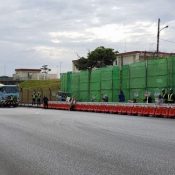
April 15, 2020 Ryukyu Shimpo online edition
On April 14 the “All-Okinawa Coalition” (All-Okinawa Kaigi), which is made up of political parties and citizens’ groups that oppose relocation of Futenma Air Station to Henoko, Nago City, announced that it is temporarily suspending protest activities such as sit-ins in front of the gate to Camp Schwab in Henoko from April 15 through May 6. Activities are being suspended for the purpose of preventing the spread of the novel coronavirus.
At approximately 9:00 a.m. on April 15 in front of the gate, about 15 city residents staged a sit-in while spaced out from each other. Although the construction was suddenly suspended, the protest continued. City residents raised their voices to say, “Shouldn’t there be a spacing of 2 meters left on the guarded side?”In order to avoid physical contact, riot police did not forcibly remove protestors, and over the same 20 minutes construction vehicles loaded with raw materials entered the military base.
According to the All-Okinawa Coalition, organized mobilization will not be carried out during the suspension period, but observational activities will continue, such as a few people watching for the number of construction vehicles and the construction status, people will be posted in front of the gate and at Oura Bay, at the Ryukyu Cement Co. Pier in Awa, and Shiokawa at Motobu Port in Motobu Town.
(English translation by T&CT and Erin Jones)
Go to Japanese
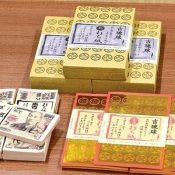
April 15, 2020 Ryukyu Shimpo
Ururma Police arrested a 22-year-old unemployed man with no fixed address for fraud and traffic violations (driving without a license) after the man used “Uchikabi,” imitation paper money placed at tombs and shrines for ancestors to use in the afterlife, resembling a 10,000 yen bill, to buy cigarettes at a convenience store, receiving 9,510 yen in change.
The man has admitted to the charge of driving without a license, but is contesting the charge of fraud, apparently stating, “I thought it was real money. I thought you could use it.”
The arrest was made at 8:10 p.m. on March 5, for the suspicion of driving without a license to a convenience store, and attempting to purchase cigarettes with an uchikabi note resembling a 10,000 yen bill, fraudulently receiving 9,510 yen in change. The store employee thought the bill was a bit odd at the time, but since there were other customers waiting they did not confirm if it was “paper money.” After realizing it was uchikabi after, they dialed 110.
(English translation by T&CT and Sam Grieb)
Go to Japanese













 Webcam(Kokusai Street)
Webcam(Kokusai Street)


